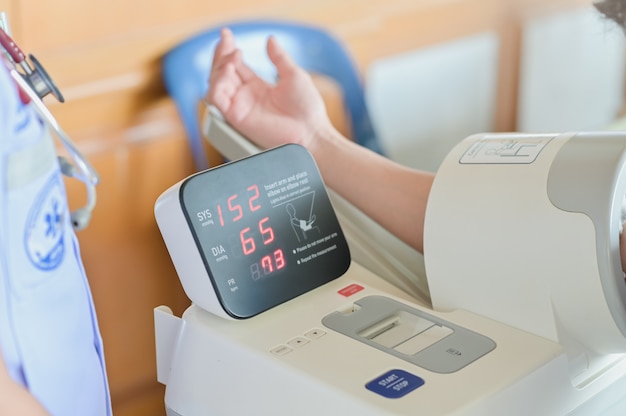Hypertension is one of the most common medical morbidities and is a condition that is associated with high blood pressure. According to statistics provided by the CDC, around 75 million adults are diagnosed with hypertension and approximately 1 in 3 American adults are at risk for developing hypertension. Though the condition is very common and with rates of diagnosis increases with age, there still seems to be misconceptions with how hypertension is diagnosed and managed and this is what this article aims to address.

What is Hypertension?
The key to understanding hypertension, or high blood pressure, is to first understand what blood pressure is. Blood pressure is the force exerted by the flow of blood on the blood vessel walls. Several factors are associated with changes in blood pressure such as heart rate or the contractility of the heart, the size of the blood vessels, and the elasticity of the walls of arteries. Of all these, the elasticity of arterial walls is more commonly associated with the development of hypertension. As we grow older, the walls of arteries become less elastic and distensible which causes blood pressure to rise. That is why the diagnosis of hypertension becomes more and more common with increasing age.
Hypertension can also be classified into two: Essential and Secondary. Essential Hypertension, which makes up the majority of cases, is hypertension that occurs without association to any other underlying medical condition. This type of hypertension occurs due to a complex interplay between several changeable and non-changeable risk factors such as age, race, family history, smoking, obesity, and a sedentary lifestyle. Essential Hypertension is a chronic medical condition and could become a risk factor for developing other co-morbidities such as heart disease, stroke, and kidney failure. It is usually treated with anti-hypertensive maintenance medications and lifestyle adjustments.
Secondary Hypertension, on the other hand, is caused by a different underlying medical condition. These could be caused by another condition that affects the kidneys, heart, or endocrine system. Specific examples of these diseases include Pheochromocytoma, which is a tumor of the adrenal glands, and Hyperthyroidism, which is an overactive thyroid. Secondary Hypertension requires a healthcare physician’s diagnosis and may include additional diagnostic tests. The treatment of this type of hypertension would require treatment of the underlying cause.

How is Hypertension diagnosed?
Blood pressure is commonly measured by the use of a Sphygmomanometer which is a medical instrument that measures pressure by the use of an inflated cuff and a pressure valve. There are both manual and digital versions of this instrument. With proper advice and instruction by a healthcare professional, the use of the Sphygmomanometer is quite simple and can be done by oneself at home to monitor their own blood pressure. The two important numbers to note are the systolic blood pressure (SBP), which is presented as the numerator), over the diastolic bleed pressure (DBP). The unit of measurement for blood pressure is millimeters mercury (mmHg) which is derived from the column of mercury that was used in older Sphygmomanometers.
The guidelines of the diagnosis of Hypertension can slightly vary from institution to institution. According to the 2017 Hypertension Guidelines by the American College of Cardiology, blood pressure can be categorized into the following groups:
- Normal Blood Pressure: < 120 (SBP) and < 80 (DBP)
- Elevated Blood Pressure/Prehypertensive: 120 – 129 (SBP) and < 80 (DBP)
- Stage 1 Hypertension: 130 – 139 (SBP) and 80 – 89 (DBP)
- Stage 2 Hypertension: 140 or higher (SBP) and 90 or higher (DBP)
What are the risk factors?
As mentioned previously, there are two groups of risk factors that are associated with the development of hypertension: Modifiable and Non-Modifiable. Non-modifiable risk factors are factors that cannot be altered such as age, race, and family history. This is exemplified by age, where statistics have shown that with increasing age, there is a higher likelihood to develop hypertension, as compared to younger patients. The modifiable risk factors are factors that can be changed, and thus, is the target for lifestyle management approaches. These are factors that include smoking, stress, sedentary lifestyle, and obesity. Once diagnosed with hypertension, a healthcare physician will advise proper lifestyle modifications such as smoking cessation, increases in exercise activity, and specific diets. These modifications have been found to help control and manage blood pressure alongside prescribed antihypertensive medications.

What are the complications associated with Hypertension?
Hypertension is a leading co-morbidity that can lead to the development of other medical conditions and overall health deterioration. Hypertension is a leading risk for the development of Heart Disease, Stroke, and Kidney Failure. These conditions can lead to significant disability and even death. According to the CDC, high blood pressure was a primary or contributing cause of death for more than 410,000 Americans in 2014.
What are the symptoms of Hypertension?
One of the most worrying features of hypertension is that it has been referred to as the silent killer. It is very common that most patients, even with long-term hypertension, do not feel any symptoms or severe disability. The lack of warning signs leads patients to disregard high blood pressure and forego seeking immediate treatment. Unfortunately, when symptoms do develop these are most likely associated with worsening medical conditions, like those previously mentioned.
The measurement of blood pressure should become routine with all healthcare consultations and check-ups. The older we get, we must be more conscious about what our normal range of blood pressure is and if we should seek work-up for hypertension. Hypertension should not be taken for granted due to the numerous debilitating medical conditions that are associated with it when left untreated. Healthcare physicians are now very well-informed and well-trained in the diagnosis and management of high blood pressure. Also, with the advancements in technology, it is now easier than ever to monitor one’s own blood pressure at home and see if they are within the normal or target range.

